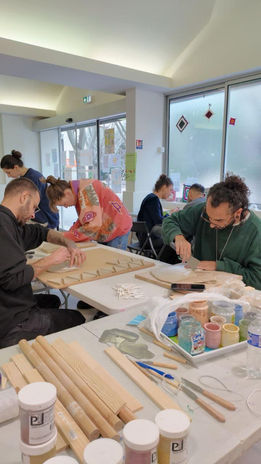

ENSEMBLE.s
ZAT Montpelier, France 2025
A participatory site-specific urban art by UV LAB
In partnership with Créature.s Créatrice.s, Esprit Libre and Laboratoire Urbain.
Financed by the City of Montpellier.
Computational design, fabrication strategy, and detailed design: Michael R. DiCarlo
Structural engineering: Quentin Alart
Parametric distribution strategy for Zellige: Jawhar Kodadi
Assembly: UV LAB
Prefabrication: AMA (Amazing Modular Architecture)
A Collective Spatial Gesture
ENSEMBLE.s is a participatory installation conceived by UV LAB for ZAT 2025 in Montpellier, nestled within the layered social and architectural fabric of La Mosson. Inspired by the ancestral art of Moroccan zellige, this contemporary structure emerges from a shared act of creation, uniting over 200 inhabitants in the design and fabrication of more than 8000 ceramic pieces—each singular, each imbued with the gesture of a hand.
At the confluence of craftsmanship and computational design, ENSEMBLE.s takes the form of a hyperboloid—a fluid, tensile geometry suspended in metal. This living architecture reclaims a previously marginal space and transforms it into a locus of resonance, contemplation, and presence. Rooted in situated knowledge and collective memory, the project offers a poetic yet tangible expression of how we might inhabit the public realm differently—together, across difference, through form.


The Workshop — A Temporary Atelier of Shared Knowledge
The making of ENSEMBLE.s unfolded through an open workshop held in the heart of the neighborhood—a two-week collective laboratory where material, memory, and imagination converged. Residents of all ages were invited to enter the atelier, to touch clay, to draw, to compose. Under the guidance of artisans and designers, more than 200 participants engaged in the ancestral language of zellige, adapting it to their own visions and sensibilities.
These workshops were not simply educational moments; they were spaces of transmission, of conviviality, of slow resistance. Here, technique met intuition. Tradition met technology. The process transformed a community of spectators into a community of authors—each ceramic fragment a silent testament to presence, to participation, to place.
Workshops led by
-
Maryam Samaan, artiste multidisciplinaire
-
Nathalie Marinier-Julien, artisane d’Art – Céramiste
-
Khaled Alwarea, co-fondateur & chargé créatif de UV LAB
-
Shnsho, co-fondateur & chargé technique de UV LAB
-
Nezha Hamdi Alaoui, Esprit Libre
-
Jaafar Fanchi, Laboratoire Urbain
Crédit photo : Aras OMAR
The Interactive Tool — Designing with Code and Memory
(Designed by Jawhar Kodadi)
To extend access and deepen participation, UV LAB invited Moroccan architect and coder Jawhar Kodadi to develop a custom interactive tool—an open digital atelier where each user could design their own zellige-inspired panel directly online. This interface bridged centuries of ornamental geometry with the logics of code, offering a playful and intuitive entry into the generative language of pattern.
The tool, accessible via any browser, transformed design into a democratic act—inviting experimentation, iteration, and authorship. Users explored symmetrical logics, tessellations, and color variations, imprinting their digital gestures onto the collective body of the installation. This convergence of algorithmic drawing and vernacular ornament opens new fields of practice where tradition becomes a living, evolving code.
Try it yourself!


The Benches — Pixelated Topographies of Rest
Arranged around the central structure, a series of sculptural benches extend the installation into the terrain—inviting bodies to linger, to gather, to inhabit the space informally. These seating modules, composed of wooden blocks, echo the pixelated logic of the ceramic tiles, translating ornamental syntax into volumetric form.
Designed parametrically and built by hand, the benches exist at the intersection of landscape and interface. They are not merely functional elements, but active agents in the spatial choreography of ENSEMBLE.s. Each bench invites appropriation—by a child climbing, an elder resting, a passerby observing. In their modularity and their warmth, they perform the core ethos of the project: form as invitation, structure as relation, architecture as care.













![logo-dynamic-[Converted]_01.gif](https://static.wixstatic.com/media/7c2942_a28e8bab1a3749ec83a2d55382226f70~mv2.gif)
























